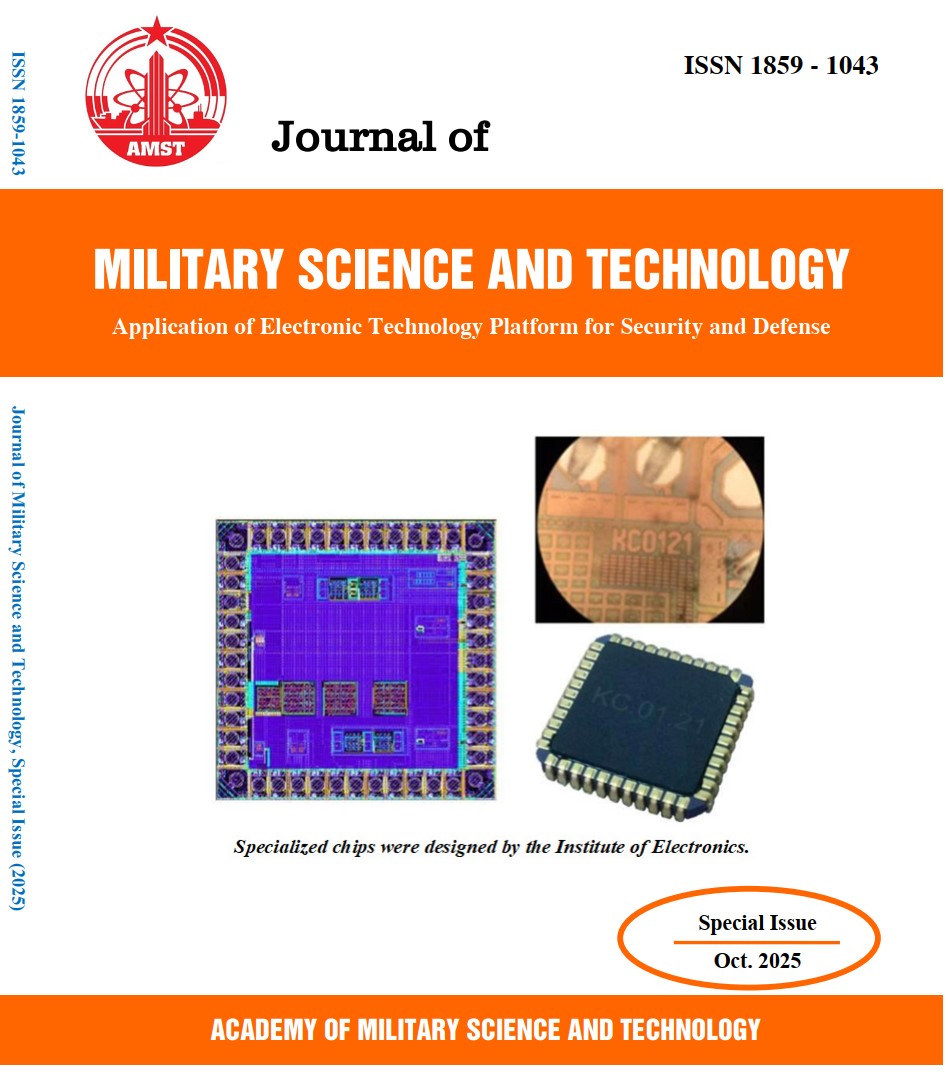Impact of Doppler effect on pilot augmentation techniques for channel estimation in UWA-OFDM systems
161 viewsDOI:
https://doi.org/10.54939/1859-1043.j.mst.IITE.2025.99-106Keywords:
OFDM; Underwater acoustic; Channel estimation; Doppler effect.Abstract
This paper investigates the impact of the Doppler effect on pilot insertion techniques for channel estimation in Underwater Acoustic Orthogonal Frequency Division Multiplexing (UWA-OFDM) systems. Accurate channel estimation is critical for reliable data transmission in underwater acoustic communications, where the propagation environment is highly dynamic and susceptible to Doppler-induced distortions. To address this challenge, several pilot augmentation strategies are evaluated with the objective of enhancing the robustness and accuracy of channel estimation. The study provides a comparative analysis of these techniques under varying Doppler conditions, highlighting their effectiveness in compensating for frequency and time shifts caused by relative motion in the underwater environment. The results demonstrate the selection of appropriate pilot structures to mitigate Doppler effects and improve overall system performance.
References
[1]. Z. Li et al., “Underwater acoustic communications,” Nature reviews electrical engineering, Vol. 2, pp. 83–95, (2025). DOI: https://doi.org/10.1038/s44287-024-00122-w
[2]. R. P. Hodges, “Underwater acoustics: analysis, design and performance of sonar,” John Wiley Sons, (2010). DOI: https://doi.org/10.1002/9780470665244
[3]. G. Qiao et al., “MIMO-OFDM underwater acoustic communication systems - a review,” Physical communication, Vol. 23, pp. 56–64, (2017). DOI: https://doi.org/10.1016/j.phycom.2017.02.007
[4]. R. v. Nee, “OFDM for wireless multimedia communications,” John Wiley Sons, (2014).
[5]. S. Zhou et al., “OFDM for underwater acoustic communications,” CRC Press, (2018).
[6]. R. Prasad, “OFDM for wireless communications systems,” Artech House, (2004).
[7]. B. Li et al., “Multicarrier communication over underwater acoustic channels with nonuniform Doppler shifts,” IEEE journal of oceanic engineering, Vol. 33, No. 2, pp. 198–209, (2008). DOI: https://doi.org/10.1109/JOE.2008.920471
[8]. Y. Liu et al., “Channel estimation for OFDM,” IEEE communications surveys & tutorials, Vol. 16, No. 4, pp. 1891–1908, (2014). DOI: https://doi.org/10.1109/COMST.2014.2320074
[9]. B. Singh et al., “Performance evaluation of MMSE and LS channel estimation in OFDM system,” International journal of engineering trends and technology (IJETT), Vol. 15, No. 1, pp. 39–43, (2014). DOI: https://doi.org/10.14445/22315381/IJETT-V15P209
[10]. M. B. Sutar et al., “LS and MMSE estimation with different fading channels for OFDM system,” in International conference of electronics, communication and aerospace technology (ICECA), Vol. 1, IEEE, pp. 740–745, (2017). DOI: https://doi.org/10.1109/ICECA.2017.8203641
[11]. J. A. Fernandez et al., “Performance of the 802.11p physical layer in vehicle-to-vehicle environments,” IEEE transactions on vehicular technology, Vol. 61, No. 1, pp. 3–14, (2012). DOI: https://doi.org/10.1109/TVT.2011.2164428
[12]. Z. Zhao et al., “Channel estimation schemes for IEEE 802.11p standard,” IEEE intelligent transportation systems magazine, Vol. 5, No. 4, pp. 38–49, (2013). DOI: https://doi.org/10.1109/MITS.2013.2270032
[13]. K. Yoon et al., “Time and frequency domain channel estimation scheme for IEEE 802.11p,” Proc. of ITSC, pp. 1085–1090, (2014). DOI: https://doi.org/10.1109/ITSC.2014.6957832
[14]. T. N. Nguyen et al., “Pilot enrichment methods for improving quality of received signal in underwater acoustic OFDM systems,” Proc. of ATC, Hanoi, Vietnam, pp. 401–406, (2022). DOI: https://doi.org/10.1109/ATC55345.2022.9943030
[15]. N. T. Nga, P. H. Anh, C. V. Loi, and P. T. Hiep, “Suitable pilot search method for channel estimation in underwater acoustic OFDM systems,” Journal of military science and technology, Vol. 89, pp. 52–59, (2023). DOI: https://doi.org/10.54939/1859-1043.j.mst.89.2023.52-59
[16]. T. N. Nguyen et al., “Reliable pilot search method for enhancing BER performance in underwater acoustic OFDM systems with MMSE estimator,” International journal of wireless information networks, Vol. 31, pp. 84–95, (2024). DOI: https://doi.org/10.1007/s10776-024-00621-5
[17]. P. Qarabaqi et al., “Statistical characterization and computationally efficient modeling of a class of underwater acoustic communication channels,” IEEE journal of oceanic engineering, Vol. 38, No. 4, pp. 701–717, (2013). DOI: https://doi.org/10.1109/JOE.2013.2278787
[18]. M. B. Porter, “The BELLHOP manual and user’s guide: preliminary draft,” Heat, Light, and Sound Research, Inc., La Jolla, CA, USA, Tech. Rep., Vol. 260, (2011).







